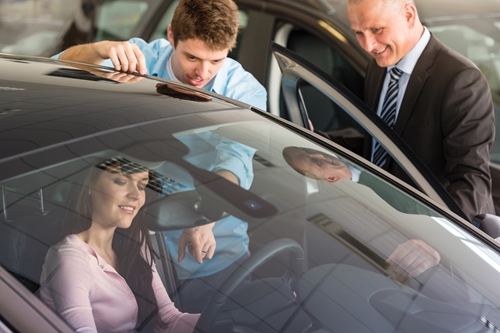Beauty in the Details: Preserving Automobiles’ Presale with Protective Tape

To prevent small blemishes from bleeding their operations dry, auto manufacturers should invest in protective tapes and films for all stages of production and distribution.
Teenagers, chomping at the bit for a smidgen of independence, will happily hop behind the wheel of any old jalopy, so long as it runs. But fast-forward a decade or two, and what happens? This teenager is now an adult car shopper – with an adult-sized salary – who probably wields a little more discretion on the car lot.
From an auto manufacturer’s perspective, discerning customers purchasing brand new vehicles don’t want to pay Blue Book prices for cars and trucks arriving at the dealership with scratches, noticeable abrasions and other cosmetic flaws. Customers won’t buy, but if they do, they’ll most likely ask for cost reductions from the dealer. That’s not good for business.
To prevent small blemishes from bleeding their operations dry, auto manufacturers should invest in protective tapes and films for all stages of production and distribution. From the moment the assembly line starts to the second after the car rolls off the lot, these safeguards will keep vehicles looking pristine and help manufacturers retain value.
Automotive assembly protection inside and out during manufacturing
Cars are comprised of a lot of different components. Toyota, for example, estimates its vehicles have upwards of 30,000 parts!
The “nuts and bolts” might be safe behind layers of steel and Plexiglas, but exposed components like the hood, doors, wheels, lights and mirrors will bear the brunt of any accident that could occur on the production floor.
“Taping over polished panels, carpet and sensitive instrument panels preserves a car’s best features.”
Covering individual components in protective tapes as cars are built serves an aesthetic purpose as well as a practical on. Not only will these parts be secure and scratch-free, but receiving dealerships will know nothing’s been tampered with.
Interior protection matters too. Taping over polished panels, carpet and sensitive instrument panels preserves a car’s best features long before any test driver plops down in the front seat.
Transportation between plant and dealership
We’ve all been on highway before and seen behemoth car carriers chugging along in the lane next to us with a half dozen vehicles in tow. Depending on the location of the manufacturer in relation to the dealer, these cars could be making a cross-country trip, exposed to all sorts of weather and debris.

Logistics itself can also beat up vehicles. Accidents can happen as haulers pull vehicles on and off of car carriers due to the cargo’s weight and the steep angles of the carrier. Here, bumper protection could mean the difference between selling an immaculate automobile and dealerships getting stuck with a scraped-up lemon.
Transit protection ensures cars arrive to the lot without defects, safeguarding their sales potential. Transit masks or hood-roof-trunk applications are a wise investment for any vehicles en route to dealerships by car carrier. Protective masking adheres closely to the contours of the vehicle and will not peel back during transportation.
Waiting for car shoppers on the lot
Once a car reaches its dealership, what happens next?
Some dealers may choose to remove the masking immediately. Low-tack protective tapes like AutoWrap peel away easily without leaving behind residue or damaging the car in the process.
Other dealers may decide they’d prefer to leave the masking on until the car has been purchased. No matter how long dealers leave protective tape on their cars, it is guaranteed to peel off just as easily as it would have on the first day the car rolled into the dealership.
Buying a brand new car is a big investment for most people. Even the smallest, least noticeable imperfections could send prospective customers walking. Instead, let protective tapes provide them with the assurance they need to drive away satisfied.


